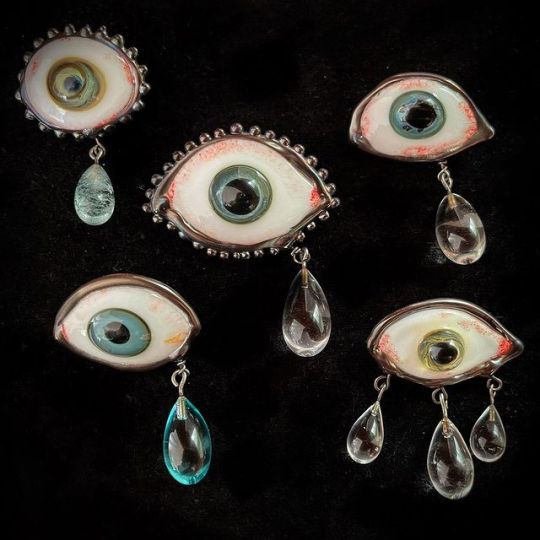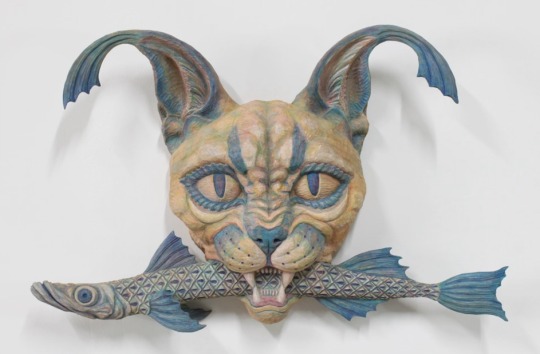the aesthetics & inspo sideblog (main is @sheydgarden)
Don't wanna be here? Send us removal request.
Photo

confirmed superstitions, Herbert Pfostl
3K notes
·
View notes
Text

My son made this wonderful composition, and a dear friend captioned it:
working in toddler-scale land art, m invites us to consider the tension between the temporary and the permanent; between nature and human construction. the viewer's eye catches on the second rock: is it wrapped in some kind foil? it has the shine of gold leaf, and its placement as second in the sequence suggests an almost radical egalitarianism. the altered stone doesn't dominate or subjugate but rather lends its halo to its neighbors.
a temporary arrangement of pure intuition forged from four easily-overlooked stones that each took millennia to smooth. brought together in a gentle display of order, set against a concrete backdrop that evokes a starfield as much as a dried riverbed, while belonging unmistakably to our anthropocene era. the even spacing between the four rocks calls to mind the steady 4/4 rhythm of popular music as much as it seems to echo a fleeting celestial alignment. an ephemeral gesture vs geologic time. the child composes, briefly curating a scene of harmony and order, before entropy inevitably clears the scene. after our efforts, again.
@uniquescience
53 notes
·
View notes
Text

6K notes
·
View notes
Photo

Bolesław Biegas (1877–1954) - The Vampire, 1916. Polish surrealist painter and sculptor.
2K notes
·
View notes
Text

Jan Švankmajer, Setkani Mineralogie Se Zoologii, 2017.
113 notes
·
View notes
Text
Incantation Bowls from Mesopotamia, c.300-700 CE: these bowls are lined with Aramaic incantations and drawings that show demons being shackled and subdued; they were often buried beneath houses and cemeteries in an effort to capture malevolent spirits
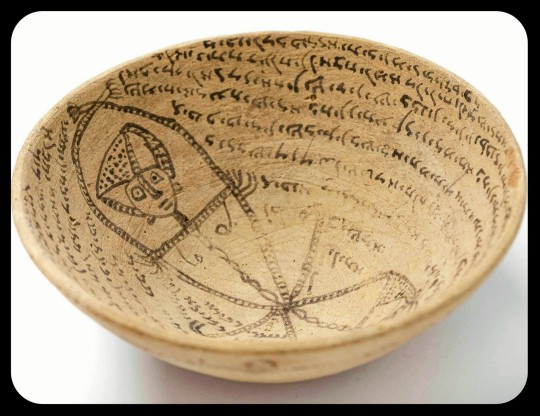
Bowls like this were once produced as magical amulets in parts of Mesopotamia (in what is now Iraq and Iran). As this article explains:
Thousands of similar incantation bowls, also known as magic bowls, were produced in the area of today’s Iraq between the fifth and eighth centuries. Clients used incantation bowls to protect and heal, to frighten off demons and evil spirits, and, in a few cases, to enlist demons to help secure love or money, or to harm adversaries. In addition to the magical texts, scribes sketched drawings of bound and chained demons – pictorial representations of the spells’ desired effect – on the bottom of about a quarter of the bowls.
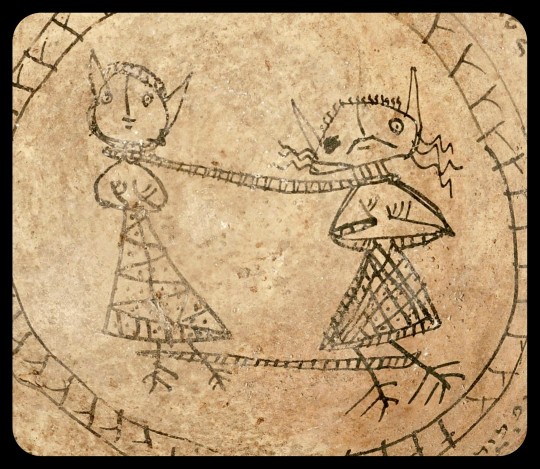
Above: this incantation bowl was commissioned by someone named Gia Bar Imma nearly 1,700 years ago, and it features a Jewish Babylonian Aramaic inscription along with a drawing of two demons wrapped in chains
These bowls were created and used by people of many different faiths. They were typically inscribed with Aramaic text, which appeared in one of three different dialects: Jewish Babylonian Aramaic, Mandaic, or Syriac. Incantations that were written in Jewish Babylonian Aramaic are, of course, attributed to Jewish communities, but the ones in Mandaic are associated with Gnostic Mandaeans, and the ones in Syriac are typically associated with Christians, Manichaeans, or followers of the ancient Babylonian religion.

Above: this bowl is lined with an Aramaic inscription that invokes "the powers of Enoch, the seven planets, and the twelve signs of the zodiac" to protect the home of a man named Pabak bar Kufithai
There are a few incantation bowls that feature Arabic or Persian inscriptions instead, and those examples tend to have Islamic or Zoroastrian motifs. Some bowls are simply inscribed with gibberish:
The largest number of known incantation bowls are written not in Syriac, but in Jewish Aramaic by Jewish scribes (though not necessarily for Jewish clients). Mandaean bowls are the second most numerous, only then followed by bowls in Syriac. A handful of bowls in Arabic and Persian are also known, in addition to bowls – perhaps 10 per cent – that can only be called ancient forgeries. These latter are filled with scribbles that mimic cursive writing but are not, in fact, in any language at all; perhaps they were made by illiterate scribes preying on equally illiterate clients.
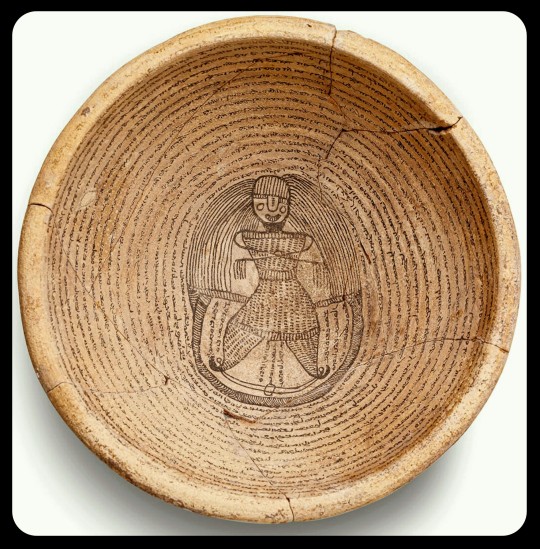
Above: this bowl features a Mandaic inscription
Incantation bowls provide valuable information about Jewish history, in particular:
The prevalence of Jewish Aramaic bowls are what makes these artefacts so important for Jewish history. They provide the sole piece of epigraphic evidence documenting Jewish language and religion at one of the most important times in Jewish history: the period of the composition of the Babylonian Talmud.
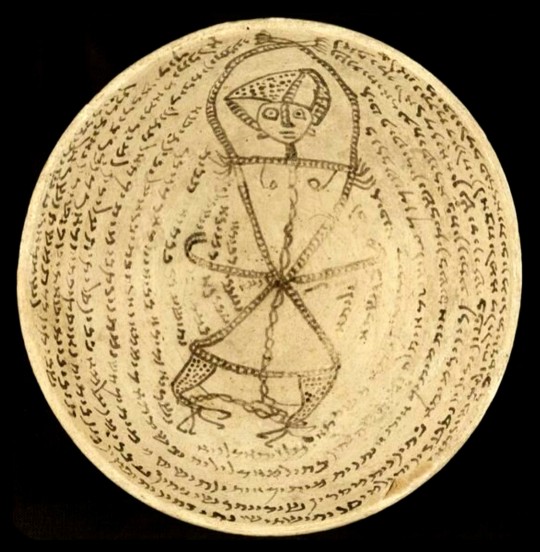
Above: researchers believe that the figure in the center of this bowl is a representation of the demon Lilith, whose likeness and/or name appears on many other incantation bowls
This article also notes:
Generally speaking, the incantations could do a number of things: healing fevers and diseases; guarding from sudden death, injustice, and treachery; and exorcising evil spirits. Similar metal talismans were made around the same time and filled largely the same role. Where they differ is that in many instances the bowls called upon deities or angels to ensnare demons. It is believed from drawings on incantation bowls depicting ensnared creatures that the reason that so many have been found upside-down is that they were intended to be traps for careless or curious demons.
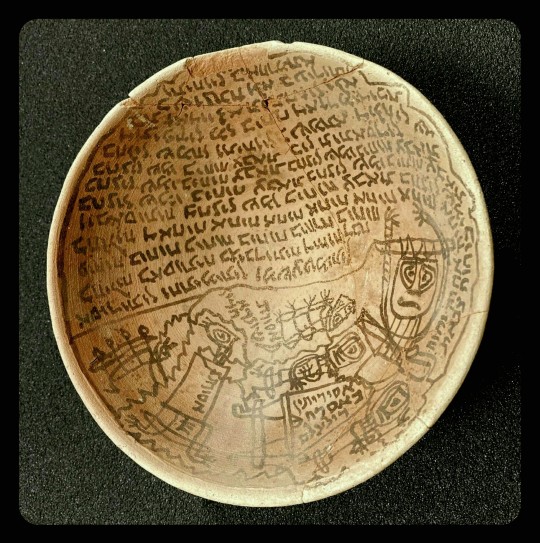
Above: this bowl has a Jewish Babylonian Aramaic inscription that includes the phrase "this cat is bound," and it features a drawing of a demonic cat being restrained
More than 2,000 of these bowls are known to exist, but only a fraction of them have been thoroughly studied.
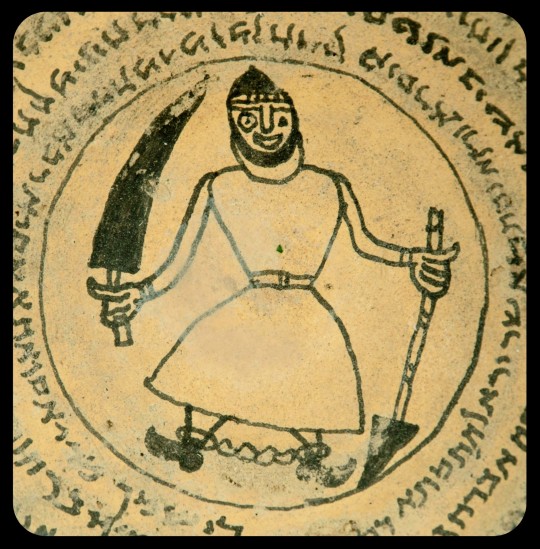
Above: an illustration from another bowl
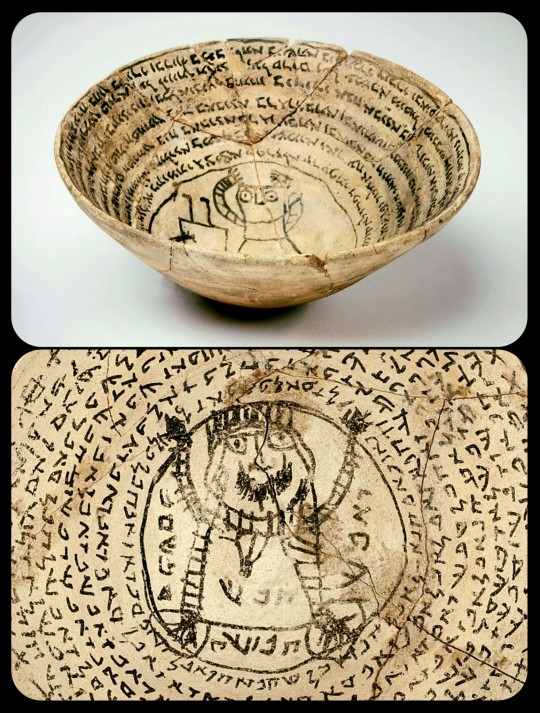
Above: two incantation bowls with Jewish Babylonian Aramaic text and drawings that show demons being restrained
Sources & More Info:
Aeon: Magic Bowls of Antiquity
Penn Today: The Stories the Bowls Tell
Bowers Museum: To Catch a Demon: Mesopotamian Incantation Bowls
Jewish Quarterly Review: Magic Formulae and Women's History: Authorship, Agency, and Gender in the Aramaic Incantation Bowls
My Jewish Learning: Magic Bowls
The Librarians: Who Wrote these Ancient Jewish Incantation Bowls?
Penn Museum: Hebrew Bowl
Journal of Late Antiquity: Enslaved People and the Demonic in the Sasanian Empire
1K notes
·
View notes
Text

Georgian key to my heart brooch featuring a heart pierced by an arrow with fine chain drop suspending a tiny key. There is a glazed panel to the centre of the heart containing woven hair surround by seed pearls. care of @antiquegemsnjewels IG
452 notes
·
View notes
Text

Hildegard von Bingen’s 23 litterae ignotae, letters for her constructed mystical language Lingua Ignota, ca. 1200.
491 notes
·
View notes
Text

you treat me like i am diseased
ink and watercolor, 4x4 inches 2025
2K notes
·
View notes
Text

shot by spencer tunick in future sex magazine no. 4
129 notes
·
View notes
Text

'many scratched doors,' 1994 in sigalit landau - gabriele horn + ruth ronen (2008)
5K notes
·
View notes
Text
It's all made up and nothing matters so become something that makes you happy

ALT: A block printed image inspired by medieval alchemy scrolls. On top is a banner that reads "Just do whatever." Beneath the banner is a sun and moon motif overlapping with a dragon serpent. The serpent is biting its own tail, which drips blood onto the final element, an egg with the head of a hen and a rooster emerging from inside. On the left and right is a fleur de lis motif.
302 notes
·
View notes



